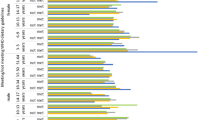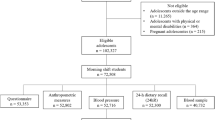Abstract
Objective
To assess the contribution of ultra-processed foods to the macronutrient intake of adolescents from low- and middle-income families in Delhi.
Method
Adolescents (n=1030) aged 12–16 years from four private and four government schools of Delhi were interviewed using 24-hour recall (repeated on three days), and a food frequency questionnaire.
Results
The mean energy intake from ultra-processed foods was 371 kcal (16.2%) of the total energy intake. The mean intake of macronutrients from ultra-processed foods was 7.1 g (16.3%) fat, 78.9 g (18.6%) carbohydrate and 4.8 g (10.9%) protein. Children from middle-income families consumed significantly higher (P<0.05) amounts of macronutrients coming from ultra-processed foods, as compared to those from low-income families.
Conclusion
Adolescents reported regular consumption of variety of ultra-processed foods, and measures to reduce this consumption and encouraging healthy food choices are urgently needed.
Similar content being viewed by others
References
Monterio CA, Cannon G, Levy R, Moubarac JC, Jaime I, Martins AP, et al. NOVA. The star shines bright. Food Classification. Public Health World Nutr. 2016;7:28–38.
Comprehensive National Nutrition Survey (CNNS. 2016–2018. Birth to Adolescence. Ministry of Health and Family Welfare. Government of India. 2019. Available from: http://nhm.gov.in/showfile.php?lid=712. Accessed October 30, 2019.
Raj M, Kumar RK. Obesity in children and adolescents. Indian J Med Res. 2010;132:598–607.
Goyal RK, Shah VN, Saboo BD, Phatak SR, Shah NN, Gohel MC, et al. Prevalence of overweight and obesity in Indian adolescent school going children: Its relationship with socio-economic status and associated lifestyle factors. J Assoc Physicians India. 2010;58:151–8.
Draft Guidelines for regulating food high in fat, sugar and salt (HFSS) also popularly known as junk food. Working Group set up by the Expert Group set up as per the order dated September 4, 2013 of the Honorable High Court of Delhi. 2017. Available from: http://www.indienvironment-portal.org.in/files/file/Junk/2520Food. Accessed October 20, 2019.
Malhotra A, Passi SJ. Diet quality and nutritional status of rural adolescent girl beneficiaries of ICDS in North India. Asia Pac J ClinNutr. 2007;16:8–16.
Sharma R. Revised Kuppuswamy’s Socioeconomic Status Scale: Explained and Updated. Indian Pediatr. 2017;54:867–70.
Gopalan C, Sastri BVR, Balasubramanian SC. Nutritive value of Indian foods. National Institute of Nutrition (NIN). 2012.
Jain A, Mathur P. Comparison of diet quality of low and middle income adolescents in Delhi, India. Indian J Public Health Res Dev. 2017;8:193–8.
Food Standards Australia New Zealand (FSANZ). The 21st Australian Total Diet Study. A total diet study of sulphites, benzoates and sorbates’. 2005. Available from: http://www.foodstandards.gov.au/publications/documents/21st%20ATD%20Study%20report-Aug051.pdf/. Accessed May 15, 2018.
Toteja GS, Rahi M, Gupta P, Rao S. Consumption pattern of carbonated water among Indian population. ICMR Task Force Study. Aravali Printers and Publishers Pvt. Ltd, 2010.
Gupta N, Shah P, Goel K, Misra A, Rastogi K, Vikram NK, et al. Imbalanced dietary profile, anthropometry, and lipids in urban Asian Indian adolescents and young adults. J Am Coll Nutr. 2010;29:81–91.
National Nutrition Monitoring Bureau (NNMB). Diet and nutritional status of rural population, prevalence of hypertension and diabetes among adults and infantand young child feeding practices. Report of third repeat survey. NNMB Technical Report Number 26, 2012.
Kaushik JK, Narang M, Parakh A. Fast food consumption in children. Indian Pediatr. 2011;48:97–101.
EAT-Lancet Commission. Healthy diets from sustainable food systems. Food Planet Health. 2019. Available from: http//:eatforum.org/content/uploads/2019/01/EAT-LancetCommission. Accessed October 20, 2019.
Funding
Funding: Senior research fellowship by University Grants Commission Government of India (AJ)
Author information
Authors and Affiliations
Contributions
Contributors: AJ: design of study, data collection, data analysis and interpretation, writing paper; PM: design of study, data interpretation, writing and review of paper.
Corresponding author
Ethics declarations
Ethical clearance: Institutional Ethics Committee of Lady Irwin College; ECR/12/INDT/DL/2014 dated May 06, 2014.
Competing interest: None stated.
Rights and permissions
About this article
Cite this article
Jain, A., Mathur, P. Intake of Ultra-processed Foods Among Adolescents From Low- and Middle-Income Families in Delhi. Indian Pediatr 57, 712–714 (2020). https://doi.org/10.1007/s13312-020-1913-8
Received:
Revised:
Accepted:
Published:
Issue Date:
DOI: https://doi.org/10.1007/s13312-020-1913-8




